
The Solar-Terrestrial Centre of Excellence (STCE) is a collaborative network of the Belgian Institute for Space Aeronomy, the Royal Observatory of Belgium and the Royal Meteorological Institute of Belgium.
 |
Published by the STCE - this issue : 10 Sep 2015. The Solar-Terrestrial Centre of Excellence (STCE) is a collaborative network of the Belgian Institute for Space Aeronomy, the Royal Observatory of Belgium and the Royal Meteorological Institute of Belgium. |
| Archive of the newsletters | Subscribe to this newsletter by mail |
Solar polar faculae (PF) appear in white light as bright points near the northern and southern solar poles, usually at heliographic latitudes greater than about 60 degrees. In contrast to their equatorial counterparts (the main zone faculae), they are pointlike, less bright, and randomly distributed. Faculae are local concentrations of magnetic field, but not that strong that they can form sunspots. The SDO/HMI images underneath show main zone faculae fields (in the gray dashed circles) on 26 July 2015, as well as -for the same day- a highly magnified view of the south pole with some polar faculae indicated by arrows (bright dots).
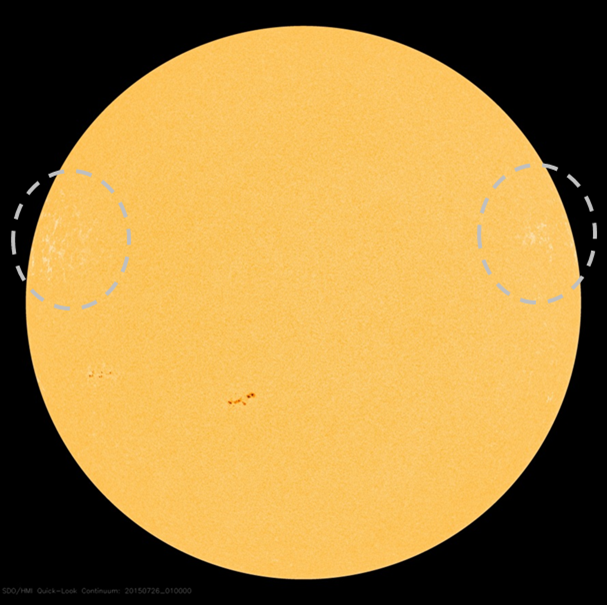

An important difference between the PF and main zone faculae is that the number of PF evolves oppositely to the "normal" solar cycle, i.e. PF are most numerous during solar cycle minima, and (near) zero during solar cycle maxima. The latter corresponds to the period of polar magnetic field reversal, offering an explanation for the absence of the PF during these years. Interestingly, over the last few months, observers of the Belgian solar section (see their newsletter at http://www.vvs.be/werkgroepen/werkgroep-zon/nieuwsbrieven ) noticed a significant increase in the number of PF near the Sun's south pole. This can be seen in graph underneath, showing an observer's smoothed number of polar faculae for the northern (blue) and southern solar pole (red). The sudden increase in southern polar faculae (shown at the end of the graph) is a bit unexpected because the next solar minimum is still many years away.
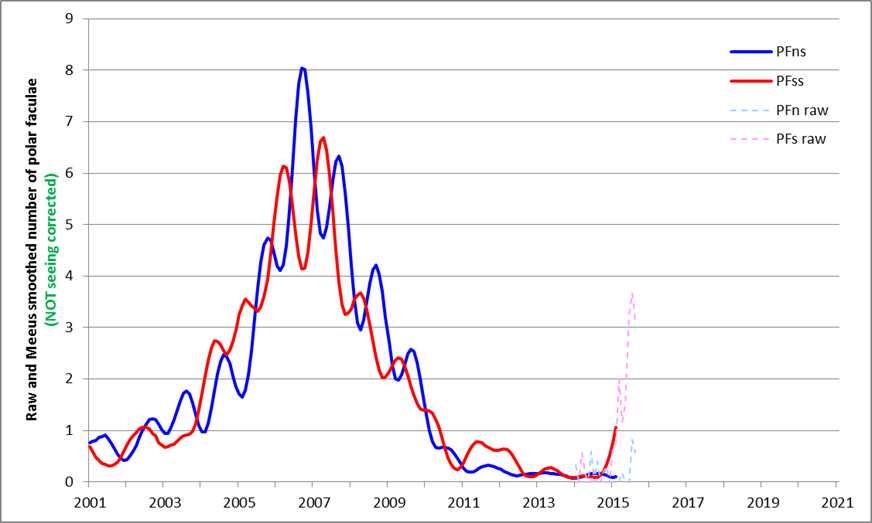
What seems to be happening is that a surge of negative magnetic field flux reached the south pole late in 2014, cancelling and effectively overturning the previously existing southern polar magnetic field of opposite polarity. This can be seen in the annotated magnetic diagram underneath from NASA/Ames Research Center (http://solarscience.msfc.nasa.gov/images/magbfly.jpg ). Yellow is positive polarity and blue is negative. Increased PF activity associated to the arrival of such surges has been documented in the past by professional solar observers such as N. R. Sheeley (e.g. in 1974: see http://adsabs.harvard.edu/abs/2008ApJ...680.1553S ). No such *strong* surge has been observed near the north pole so far this cycle, despite the polar field reversal having taken place there more than a year before the southern one. Completely conform to these findings, no obvious increase in PF has been observed near the north pole during the last two years.
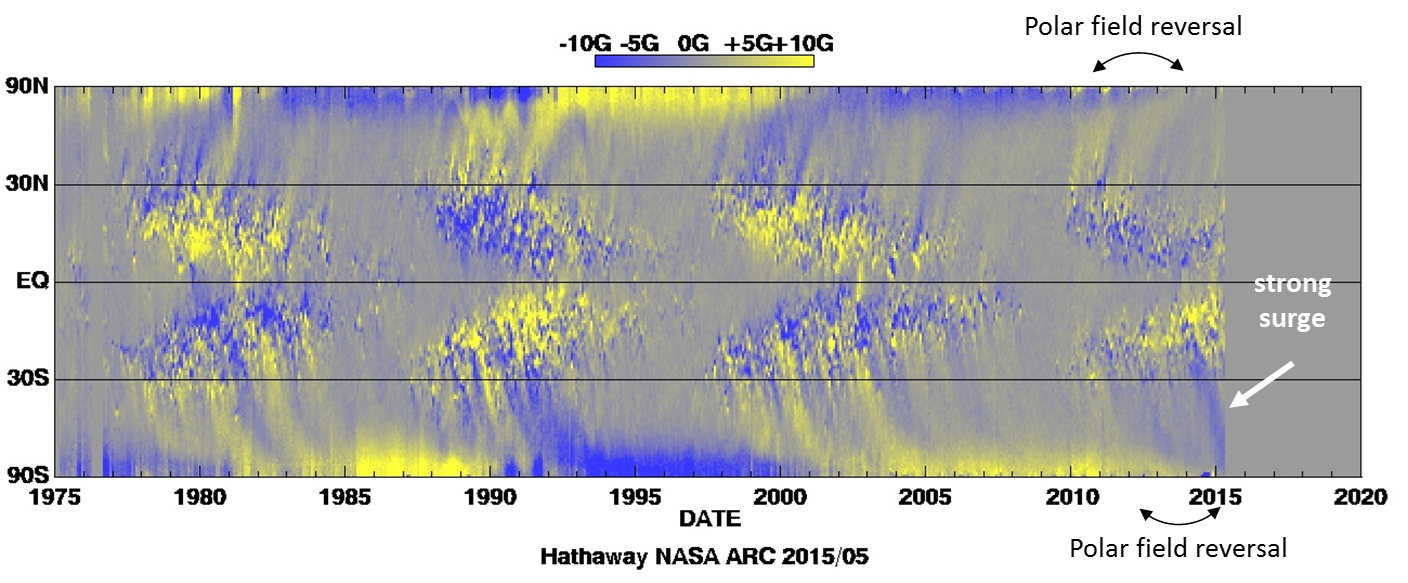
Magnetic field measurements by the Wilcox Solar Observatory (http://wso.stanford.edu/gifs/Polar.gif ) independently confirm the magnetic ongoings near the Sun's poles, with neutral (close to zero) values near the north pole (in "blue"), and a sharp upturn in magnetic field strength near the south pole (in "red"; see chart underneath). Just as for the PF, the undulations (regular up-and-downs) are caused by the fact that Earth has a better view on the Sun's south pole during spring months, and on the north pole during autumn because of the tilt of the solar rotation axis. The values of the polar field strength can be used for the prediction of the strength of the upcoming solar cycle, but for solar cycle 25, an accurate prediction is still a few years away (awaiting stable fields at maximum strength). For SC24 predictions, one can refer to e.g. Svalgaard (2005) at http://adsabs.harvard.edu/abs/2005GeoRL..32.1104S and Schatten (2005) at http://adsabs.harvard.edu/abs/2005GeoRL..3221106S ).
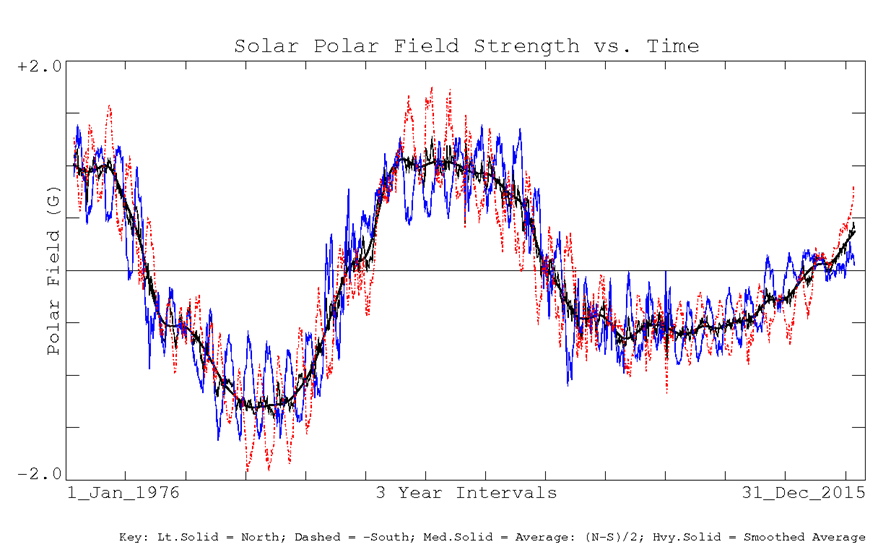

STAFF, the software to cruise through data of the solar system is upgraded. STAFF is a dynamic online timeline viewer which allows you to plot and compare data with a few mouse clicks. You can dig now into GOES data up to 1986, radio 10.7 cm flux data up to 1947. You are given more control on plotting options.
Become the captain of the heliospheric cruise ship STAFF : http://www.staff.oma.be
Happy cruising!
Solar flare activity fluctuated between very low and low during the week.
In order to view the activity of this week in more detail, we suggest to go to the following website from
which all the daily (normal and difference) movies can be accessed:
http://proba2.oma.be/ssa
This page also lists the recorded flaring events.
A weekly overview movie can be found here (SWAP week 284).
http://proba2.oma.be/swap/data/mpg/movies/weekly_movies/weekly_movie_2015_08_31.mp4
Details about some of this week’s events, can be found further below.
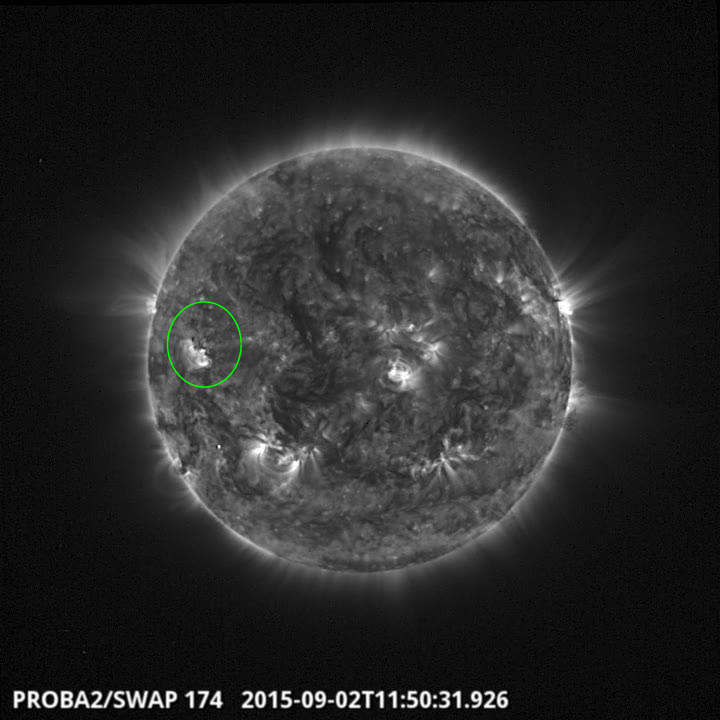
Dimming in the East @ 11:50 UT on 02Sep2015 SWAP image
Find a movie of the event here (SWAP movie)
http://proba2.oma.be/swap/data/mpg/movies/20150902_swap_movie.mp4
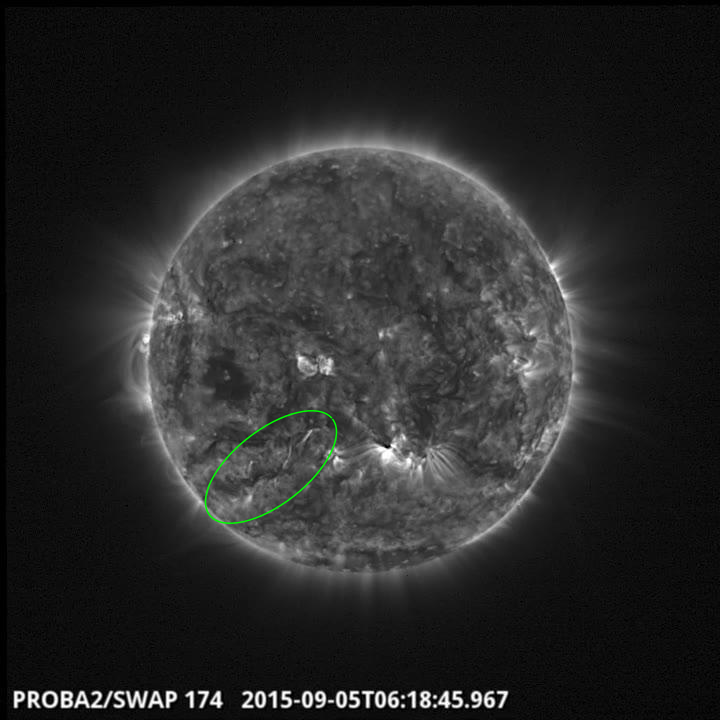
Flows in the south east @ 06:18 UT on 05Sep2015 SWAP image
Find a movie of the event here (SWAP movie)
http://proba2.oma.be/swap/data/mpg/movies/20150905_swap_movie.mp4
Solar activity was very low all week, only 2 minor C-class flares occurred. A slow and faint partial halo CME (directed to the south) erupted on September 4th did arrive at the Earth on September 7th around 12 UT.
A mild fast speed stream affected the Earth starting on September 2 and produced isolated active conditions (Kdourbes=4) on September 4, 5 and 6.
The fast speed stream was associated with a small equatorial coronal hole which passed the central meridian on August 29.
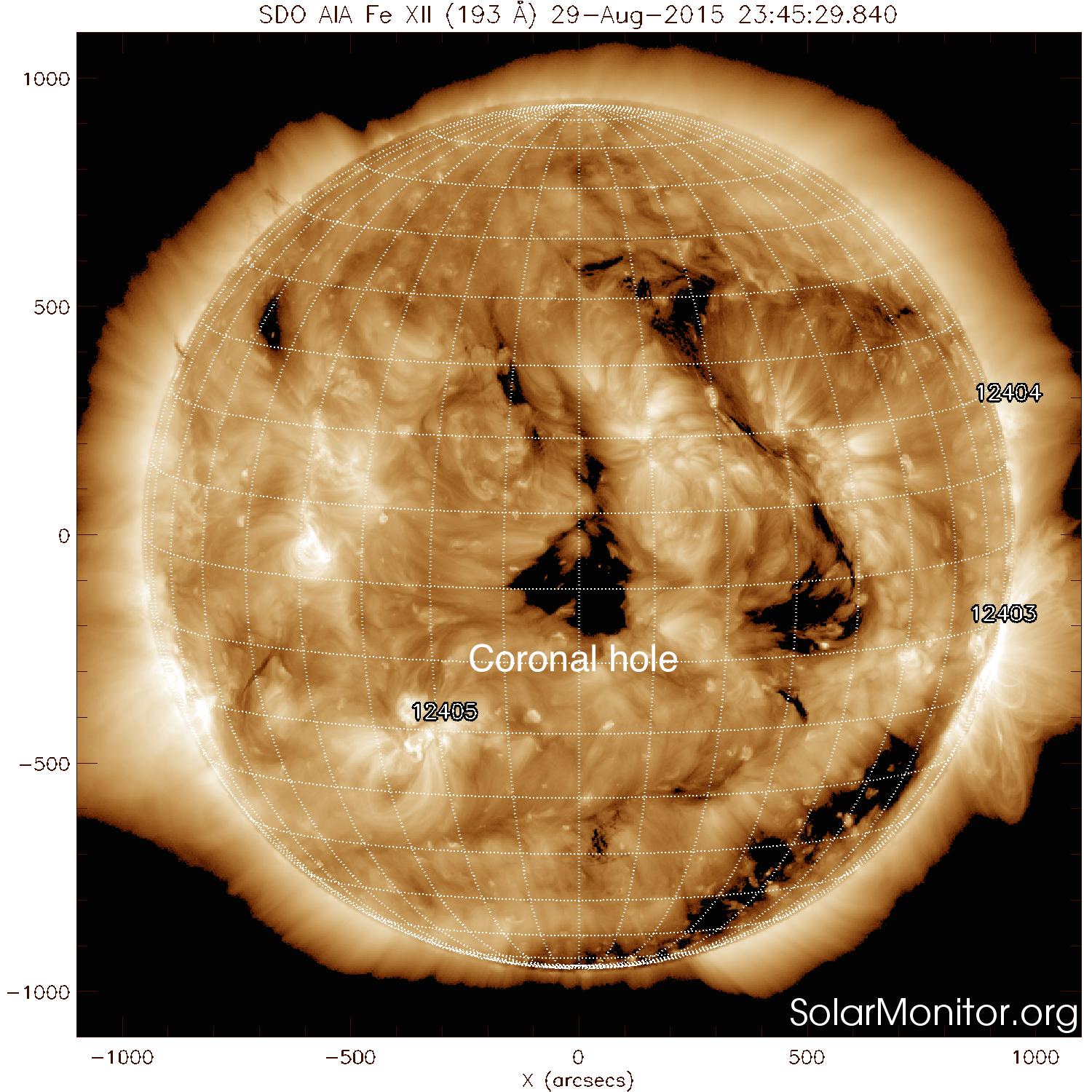
On September 2, the Earth passed the boundary from an inward to an outward pointing magnetic sector.
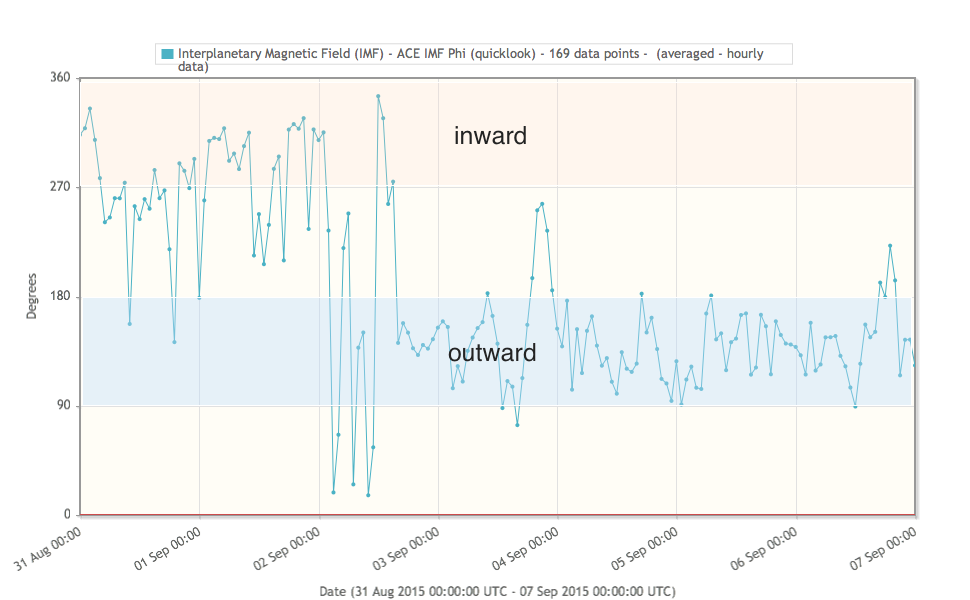

Daily Estimated International Sunspot Number (EISN, red curve with shaded error) derived by a simplified method from real-time data from the worldwide SILSO network. It extends the official Sunspot Number from the full processing of the preceding month (green line). The plot shows the last 30 days (~ one solar rotation). The horizontal blue line shows the current monthly average, while the green dots give the number of stations included in the calculation of the EISN for each day.

The figure shows the time evolution of the Vertical Total Electron Content (VTEC) (in red) during the last week at three locations:
a) in the northern part of Europe(N61°, 5°E)
b) above Brussels(N50.5°, 4.5°E)
c) in the southern part of Europe(N36°, 5°E)
This figure also shows (in grey) the normal ionospheric behaviour expected based on the median VTEC from the 15 previous days.
The VTEC is expressed in TECu (with TECu=10^16 electrons per square meter) and is directly related to the signal propagation delay due to the ionosphere (in figure: delay on GPS L1 frequency).
The Sun's radiation ionizes the Earth's upper atmosphere, the ionosphere, located from about 60km to 1000km above the Earth's surface.The ionization process in the ionosphere produces ions and free electrons. These electrons perturb the propagation of the GNSS (Global Navigation Satellite System) signals by inducing a so-called ionospheric delay.
See http://stce.be/newsletter/GNSS_final.pdf for some more explanations ; for detailed information, see http://gnss.be/ionosphere_tutorial.php
Start : 2015-10-26 - End : 2015-10-29
Erupting prominences/filaments, surges, flares, and coronal mass
ejections (CMEs) are prominent examples of the dynamic Sun.
Multi-wavelength and multi-instrument observations have the
potential to reveal highly energetic physical processes on the Sun
reaching from the photosphere, over the chromosphere and the
transition region, to the corona and beyond. Solar physicists have
nowadays access to a suite of new ground-based observing facilities
including, for example, the 1.5-meter GREGOR solar telescope at the
Observatorio del Teide, Tenerife, Spain, the European Low Frequency
Array (LOFAR), the Atacama Large Millimeter/Submillimeter Array
(ALMA) in Chile, and the Coronal Multi-Channel Polarimeter for
Slovakia (COMP-S) at Lomnicky Peak Observatory. A powerful fleet of
space missions, for example, the Reuven Ramaty High Energy Solar
Spectroscopic Imager (RHESSI), the Japanese Hinode, and the Solar
Dynamics Observatory (SDO), adds more capabilities to investigate
magnetic fields, complex plasma flows, and accelerated particle,
and thermal properties of solar eruptive events. In the tradition
of the series of »Potsdam Thinkshops«, we
invite instrument specialists, observers, modellers, and theorists
to exchange ideas, to stimulate discussion, to initiate future
collaborations among participants, and to attract new users of
instruments by showcasing the capabilities. The aim is to make
progress towards a comprehensive description of solar eruptive
events effectively aggregating their global properties as well as
their highly dynamic fine structure. Thinkshop 12 takes place at
the science park »Albert Einstein«, home to
AIP's Great Refractor and the Solar Observatory Einstein Tower at
the Telegraphenberg.
Website:
https://thinkshop.aip.de/12/cms/
Start : 2015-10-26 - End : 2015-10-29
The IRIS-5 workshop will be conducted at the Inter-University
Centre for Astronomy and Astrophysics (IUCAA), Pune, India from
October 26-29, 2015. This workshop is mainly aimed at the
participants who could not attend IRIS-4, which is being held at
Boulder, USA. Therefore, set up of the IRIS-5 workshop would be
essentially be very similar to that of IRIS-4.
The main aim of the workshop is to introduce the Interface
Region Imaging Spectrometer (IRIS) to students and young post docs.
This would be done through tutorials on IRIS data analysis, physics
of optically thick radiative transfer, MHD simulations of the solar
atmosphere related to IRIS and hydrodynamic simulations of flares.
There will be lectures as well as hands on sessions.
Website:
http://www.iucaa.ernet.in/~solar/Welcome.html
Start : 2015-11-09 - End : 2015-11-11
The fundamentally most important source of inner heliospheric
plasma physics and space weather is the active Sun, its solar
active region eruptions. Prediction of the evolution and influence
of solar active regions on solar storms in the near-Earth
environment is of particular interest to several forecasting
institutions, industrial stakeholders, and the public in
general.
State-of-the-art solar storm prediction tools are limited to
monitoring solar active regions, registering eruptions and mass
ejections while attempting, then, at extrapolating subsequent
evolution and spatio-temporal propagation: no realistic
physics-based and data-driven synthesis tool exists, which is
capable of predicting when a solar flare will be triggered, or when
a Coronal Mass Ejection will be launched into inter-planetary
space. In short, we are not yet able to answer the question: When
and why do solar storms launch?
Our meeting will be focused around initiation of space weather
events at the Sun. We will discuss and develop three major
challenges, and we aim to develop a draft resolution road-map for
those challenges during the meeting.
Website:
https://indico.nbi.ku.dk/conferenceDisplay.py?confId=817
Start : 2015-11-13 - End : 2015-11-13
With the launch of NASA's Solar Dynamics Observatory (SDO)
mission on 02/11/2010, researchers in solar physics have entered
the era of Big Data. The Atmospheric Imaging Assembly (AIA)
instrument on SDO provides imaging data and the Helioseismic and
Magnetic Imager (HMI) instrument on SDO provides magnetic field
data. Both instruments record data at a high spatial resolution and
a time cadence, amounting to about 1 Petabyte of scientific data
each year. The Big Data challenges in Solar Astronomy are expected
to grow even further with the inauguration of the NSF funded Daniel
K. Inouye Solar Telescope (DKIST), currently under construction in
Hawaii. This telescope is expected to generate: 3-5 Petabytes of
data per year.
Start : 2016-06-27 - End : 2016-07-01
Website:
http://www.issibern.ch/program/workshops.html